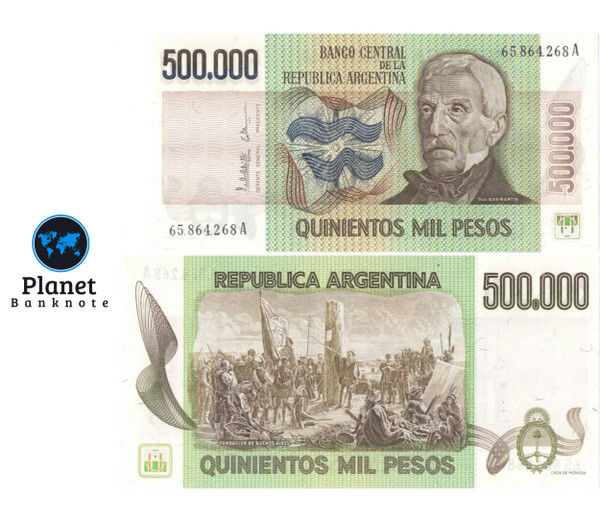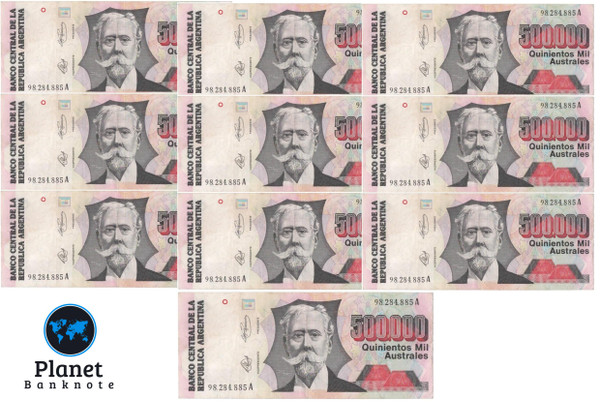-


1979–1981 Argentina 500,000 Pesos Banknote P-308b San Martín UNC Crisp Hyperinflation Era
Inc. TaxInc. TaxRRP: Inc. Tax$67.00RRP:UNC 1979–1981 Argentina 500,000 Pesos P-308b San Martín banknote from hyperinflation era This 500,000 Pesos banknote from Argentina (1979–1981), catalogued as -


1945 Hungarian 100,000 pengő Banknote NEW CRISP UNC Hyperinflation
Inc. TaxInc. TaxRRP: Inc. Tax$99.00RRP:1945 Hungarian 100,000 pengő Hyperinflation Banknote NEW CRISP UNCIRCULATED BANKNOTE VERY RARE IN THIS CONDITION The 1945 Hungarian 100,000 pengő banknote, is a significant artifact from one of the... -


1991 Argentina 500,000 Australes/Peso Banknote Lot (10 pcs) P-338 Hyperinflation Era Circulated Notes
Inc. TaxInc. TaxRRP: Inc. Tax$89.00RRP:1991 Argentina 500,000 Australes Banknote Lot (10 pcs) P-338 Hyperinflation Era Circulated Notes This listing offers a set of 10 genuine 500,000 Australes banknotes, issued in 1991 by the -


1946 Hungarian 10,000,000 Milpengő (10 Trillion Pengo) P-129 Hyperinflation Banknote CRISP UNC NEW
Inc. TaxInc. TaxRRP: Inc. Tax$169.00RRP:1946 Hungarian 10,000,000 Milpengő (10 Trillion Pengo) P-129 Hyperinflation Banknote NEW CRISP UNCIRCULATED VERY RARE IN THIS CONDITION The 1946 Hungarian 10,000,000 Milpengő banknote, cataloged as... -


1946 Hungarian 1,000,000 Milpengő NEW CRISP UNC Banknote P-128 (One Trillion Pengő) Hyperinflation Icon
Inc. TaxInc. TaxRRP: Inc. Tax$124.00RRP:1946 Hungarian 1,000,000 Milpengő NEW CRISP UNCIRCULATED Banknote P-128 (One Trillion Pengő) Hyperinflation Icon The 1946 Hungarian 1,000,000 Milpengő banknote, equivalent to one trillion Pengő,...
Description
1979–1981 Argentina 100,000 Pesos Banknote P-308b San Martín UNC Crisp Hyperinflation Era
This 100,000 Pesos banknote from Argentina (1979–1981), catalogued as Pick P-308b, is an exceptional historical artifact from the height of Argentina’s inflationary period preceding the 1980s currency reform. Issued by the Banco Central de la República Argentina, it represents one of the higher denominations of the “Peso Ley 18.188” series, printed during a time when the Argentine peso’s value was rapidly eroding due to chronic inflation.
Design and Features:
The obverse prominently features a detailed engraved portrait of General José de San Martín, the nation’s most celebrated military leader and liberator. His stoic expression and commanding presence symbolize Argentina’s enduring struggle for independence and national identity. Surrounding the portrait are intricate guilloche patterns in pastel tones of green, blue, and rose, alongside bold red and gray numerals that announce the impressive denomination of 100,000 Pesos.
The reverse of the note depicts the Casa de Moneda de la Nación Argentina—the National Mint building in Buenos Aires—rendered in precise intaglio engraving. This building is not only the birthplace of Argentina’s currency but also a monument to its economic sovereignty. The national emblem and ornate security patterns frame the architectural scene, reinforcing the note’s official and patriotic design.
Historical Significance:
Issued between 1979 and 1981, this note circulated during the final years of the “Peso Ley” before being replaced by the “Peso Argentino” in 1983. Its enormous face value illustrates the deepening inflation that characterized Argentina’s economy at the time. These high-denomination notes stand as reminders of a nation’s resilience in the face of economic hardship—an era that shaped Argentina’s modern financial history.
Authenticity and Cataloging:
-
Country: Argentina
-
Denomination: 100,000 Pesos
-
Years of Issue: 1979–1981
-
Pick Number: P-308b
-
Printer: Casa de Moneda, Buenos Aires
-
Condition: Uncirculated (Crisp, original paper)
Collector’s Value:
The Argentina 100,000 Pesos (P-308b) is a must-have for collectors specializing in hyperinflation-era currency. Its impressive denomination, rich historical narrative, and pristine uncirculated condition make it both a conversation starter and a meaningful piece of Latin American monetary history. It’s a striking testament to Argentina’s complex economic journey and a standout addition to any world banknote collection.






